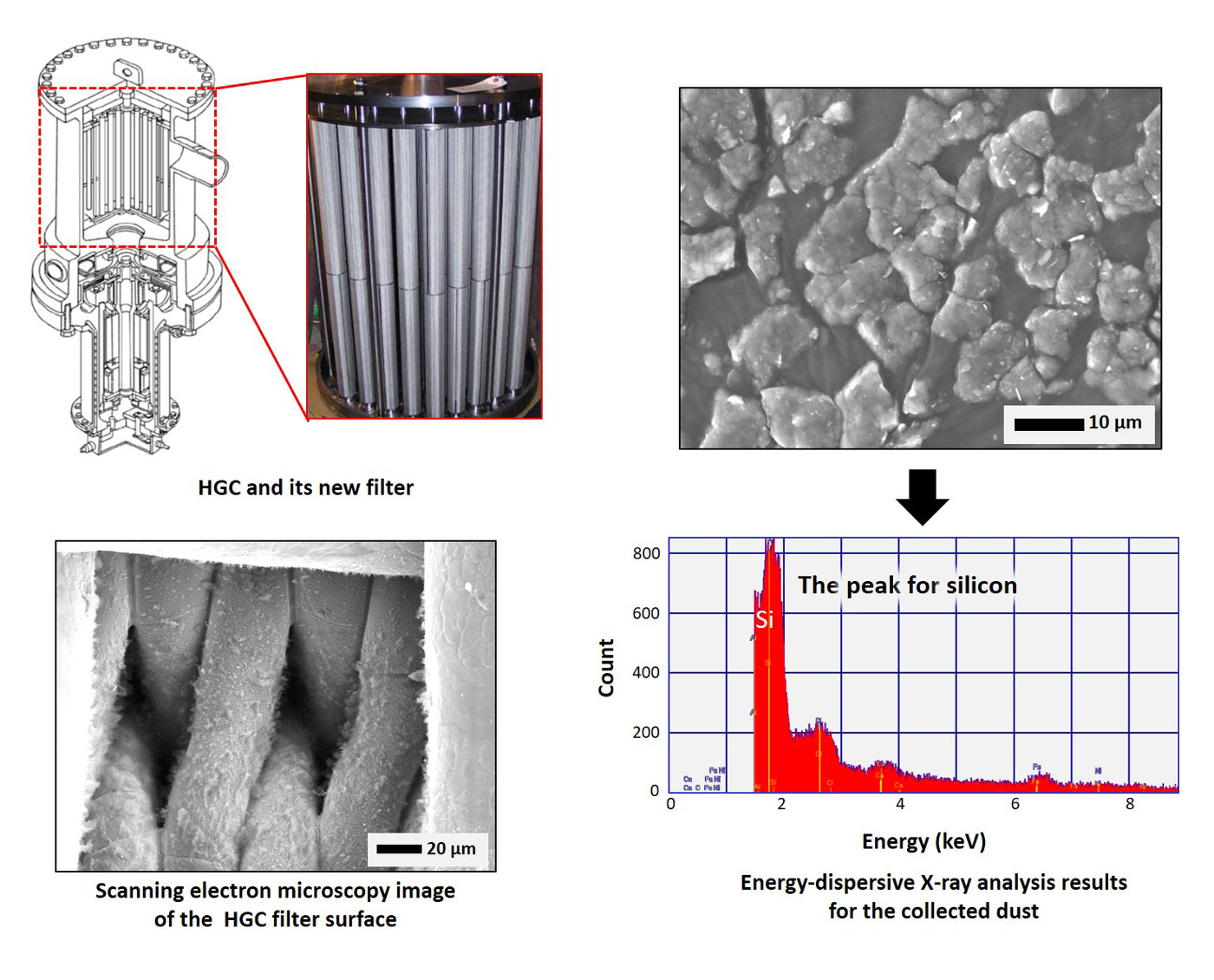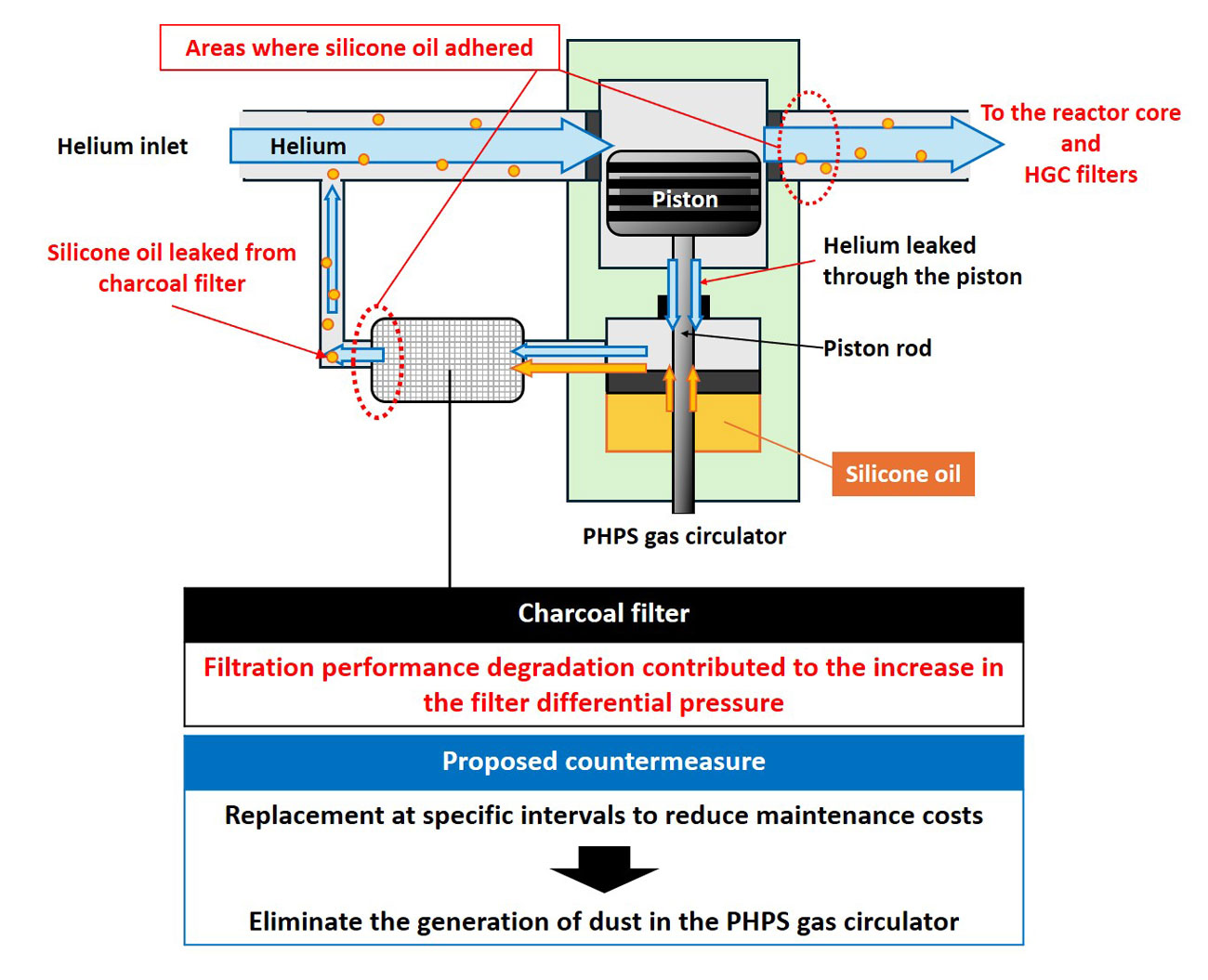 |
Topics
Countermeasure to Prevent an Increase in Filter Differential Pressure in HTTR Helium Gas Circulators
−Identifying Dust Contributing to Increase in Filter Differential Pressure−

Fig. 1 Dust on the filter surface (left) and the elemental analysis result of the collected dust (right)
The filter surface was uniformly covered with dust, which upon sampling, was found to primarily comprise silicon, similar to silicone oil.

Fig. 2 Mechanism and proposed countermeasure for silicone oil ingress into the reactor core
Silicone oil serves as a barrier to prevent helium from leaking into the lower section of the PHPS gas circulator. Usually, the silicone oil spilled along the piston rod is adsorbed by the charcoal filter. However, it was confirmed that the charcoal filter had degraded and silicone oil had entered the reactor core, as evidenced by the presence of silicone oil in the area marked in red. As a countermeasure, the charcoal filter replacement cycle was revised.
High-temperature gas-cooled reactors (HTGRs) use graphite structures in the core, and there is concern about the impact of graphite dust on the reactor system. To address this and other problems, the helium gas circulator (HGC) of the high temperature engineering test reactor (HTTR) has a filter to collect dust in the helium coolant. Previously, dust from the sliding parts of the primary helium purification system (PHPS) gas circulator, rather than graphite dust from the core, led to increased filter differential pressure*. Improvements were made to these sliding parts and the filter differential pressure remained within the normal range. However, it increased again during operation in 2021. This study investigates the cause of the phenomenon.
Filter analysis revealed that the dust adhered to the filter surface contains elemental silicon (Fig. 1). Furthermore, silicone oil from the PHPS gas circulator was found to have ingressed into the core (Fig. 2), indicating that silicone oil is the source of the silicon contributing to the increase in the filter differential pressure. The ingress of silicone oil was attributed to the degradation of the charcoal filter used in the PHPS gas circulator. Consequently, the replacement cycle for this charcoal filter was revised to occur at specific intervals.
The filter differential pressure is increased by silicone oil, indicating that the prismatic-type HTGRs, such as the HTTR generate very little graphite dust from the core. Based on the past event, the PHPS gas circulator is considered a source of particles contributing to the increase in filter differential pressure. By reviewing the replacement cycle of the charcoal filter, the generation of dust in the PHPS gas circulator is expected to be eliminated.
Filter analysis revealed that the dust adhered to the filter surface contains elemental silicon (Fig. 1). Furthermore, silicone oil from the PHPS gas circulator was found to have ingressed into the core (Fig. 2), indicating that silicone oil is the source of the silicon contributing to the increase in the filter differential pressure. The ingress of silicone oil was attributed to the degradation of the charcoal filter used in the PHPS gas circulator. Consequently, the replacement cycle for this charcoal filter was revised to occur at specific intervals.
The filter differential pressure is increased by silicone oil, indicating that the prismatic-type HTGRs, such as the HTTR generate very little graphite dust from the core. Based on the past event, the PHPS gas circulator is considered a source of particles contributing to the increase in filter differential pressure. By reviewing the replacement cycle of the charcoal filter, the generation of dust in the PHPS gas circulator is expected to be eliminated.
*Inaba, Y. et al., Investigation on Dust Captured by Quintuple Filters Installed Upstream of Primary Gas Circulators in HTTR, Journal of Nuclear Science and Technology, vol.51, issues 11–12, 2014, p.1373–1386.
Author (Researcher) Information
 | Name | Toshinari Hasegawa |
|---|---|
| HTTR Reactor Engineering Section, Department of HTTR, Oarai Nuclear Engineering Institute |
Reference
Paper URL: https://doi.org/10.13182/T130-43289
March 10, 2025
HTGR Hydrogen and Heat Application Research
